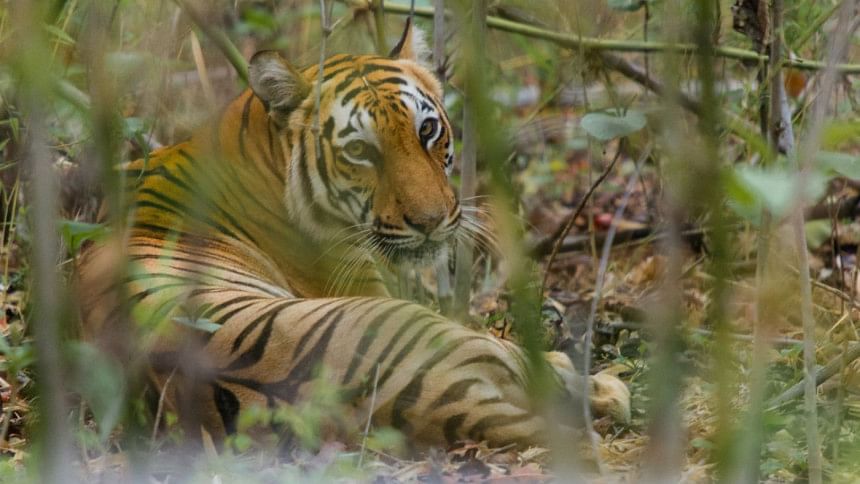Will Bengal tigers really disappear from the Sundarbans?

We recently published an article titled "Combined effects of climate change and sea-level rise project dramatic habitat loss of the globally endangered Bengal tiger in the Bangladesh Sundarbans" in Science of the Total Environment journal. The findings of our study have been highlighted in leading national and international newspapers including The Daily Star.
The Bengal tiger (or Panthera tigris tigris, its scientific name) is geographically restricted to only Bangladesh, Bhutan, India, Nepal, and Myanmar. Spanning more than 10,000 square kilometres, the low-lying Sundarbans region of Bangladesh and India is the biggest mangrove forest on earth, and the most critical area for the survival of the Bengal tiger.
We used a modelling approach called MaxEnt (maximum entropy modelling) in our study and utilised 19 climatic variables and projections available in WorldClim database including two scenarios (i.e. RCP6.0 and RCP8.5) developed by the Intergovernmental Panel on Climate Change (IPCC). The scenarios are based on plausible ranges of global greenhouse gas emissions and/or concentrations, where RCP8.5 is a substantially rising pathway and RCP6.0 is an intermediate pathway.

To predict the future distribution of Bengal tigers in the Sundarbans, we used two reference years: 2050 and 2070. Other variables used in our study were tigers' presence points in the Sundarbans, vegetation pattern of the Sundarbans, and digital elevation model of the area obtained from NASA's Shuttle Radar Topography Mission (SRTM). We also superimposed three major wildlife sanctuaries to assess the ability of existing terrestrial-protected area networks to support Bengal tiger habitats in the Sundarbans.
Our study projected a dramatic decline in suitable Bengal tiger habitats in the Sundarbans. Other than the various aspects of local climate, we found that sea-level rise will have a substantial negative impact on Bengal tiger habitats in this low-lying delta system. Our model also predicts that due to the combined effects of climate change and sea-level rise, there will be no suitable Bengal tiger habitat remaining in the Sundarbans by 2070.
Most of the future suitable Bengal tiger habitats will be confined within or in the periphery of the Sundarbans (west and south) Wildlife Sanctuary, which is closer to the Indian part of the Sundarbans and has relatively greater salinity than the rest of the Sundarbans. Quite interestingly, it is also one of the lower elevational zones and dominated by tree species such as Goran (Ceriops decandra). The area is also quite far from human settlements and, thereby, less prone to anthropogenic disturbance.

The finding of our study is definitely alarming for Bangladesh, the Sundarbans, and the magnificent Bengal tiger, a national pride of the country. However, like many other modelling studies, our study is also based on several assumptions. For example, as the Sundarbans are located in an active delta system, and mangroves are "ecosystem engineers", there have been regular losses and gains of land area due to erosion and land accretion. The tropical cyclone is a common phenomenon in that area as well and has resulted in tiger fatalities. Industrial developments, including the new coal-based power plant, are also a threat. Other factors that can also control the tiger population include disease outbreak, poaching of tigers, reduction in the prey population, etc. Our study didn't consider these factors due to sparse spatially explicit data. The actual scenario, therefore, could be better or worse than that of our projection.
The findings, however, also gave us some hope as they brought global attention to the vulnerability of the Bengal tiger in the Sundarbans due to climate change and associated sea-level rise. The Sundarbans are a Unesco World Heritage Site and a wetland of international importance under the Ramsar convention. Thus, the more of this unique ecosystem we can conserve—by increasing protected area coverage and reducing illegal poaching—the more resilient it will be to future climatic extremes and rising sea levels. Strengthening the monitoring system and law enforcement capabilities, and improving community awareness to reduce casualties during human-tiger conflicts could also benefit the tiger population in the area.

Both the Bangladeshi and Indian parts of the Sundarbans share similar environmental, socio-economic and geographic settings, and climate change is unlikely to follow a different path in the Indian Sundarbans than in its Bangladeshi counterpart. The governments of Bangladesh and India, therefore, should work together and emphasise upon transboundary tiger conservation and monitoring for the future of the Bengal tiger in its largest habitat and world's largest mangrove forest.
Dr Sharif Ahmed Mukul is Assistant Professor, Department of Environmental Management, Independent University, Bangladesh, and Senior Research Fellow, Tropical Forests and People Research Centre, University of the Sunshine Coast, Queensland, Australia.
Email: [email protected]









Comments